During my Erasmus Semester in Nicosia, Cyprus, I had to write a research paper submitted to Professor Tao Papaioannou in the course MCOM 501. The title of the paper is “Crossing the Vertical Divide: Exploring Technical Challenges and Consumer Dynamics in Mobile Vertical Video”.
Tag: vertical video
Vertical Video Marketing
See presentation:
https://www.figma.com/file/VqXnUOFKWzz2uH9ZUaq0vZ/MCOM-Presentation?type=design&node-id=1474%3A5879&mode=design&t=lZnlIFJqTKRYtU8P-1
Introduction
With the increasing use of smartphones, the vertical use of videos is becoming more and more important, and as a result, videos in portrait format are also being promoted in social media applications. Younger audiences rarely switch to landscape when using their smartphones, mainly due to discomfort and the subjective feeling that the 16:9 format “looks nicer.” (Pogue, 2018)
Mobile users typically hold their phones vertically about 94% of the time. This preference for the vertical screen orientation of smartphones is driving the production of mobile vertical video content. This format appeals to mobile users because they can easily capture and watch video content without needing to tilt their phone 90 degrees (Mulier et al.,2021).
The Dominance of Mobile Vertical Video Marketing
With the usage of mobile devices, the trend of mobile video becoming the primary way consumers consume content. Indeed, mobile devices are the fastest growing medium for digital marketing, with smartphones driving the overall increase in consumers’ digital content viewing time. Moreover, more than 75% of all video viewing is on mobile devices. Consumers are 1.5 times more likely to watch a video on a smartphone than on a computer. Therefore, video marketers need to rethink their online strategies and implement video marketing more intensively in the mobile space and follow trends such as the vertical video trend (Mulier et al.,2021).
Research Question
“How does the effectiveness of mobile vertical video marketing influence consumer brand attitude in the era of short-form content on social media platforms?”
Paper 1 – “The Effectiveness of Mobile Vertical Video Marketing”
This Way Up: The Effectiveness of Mobile Vertical Video Marketing, Lana Mulier * & Hendrik Slabbinck * & Iris Vermeir, 23 February 2021
In the paper they published three different studies.
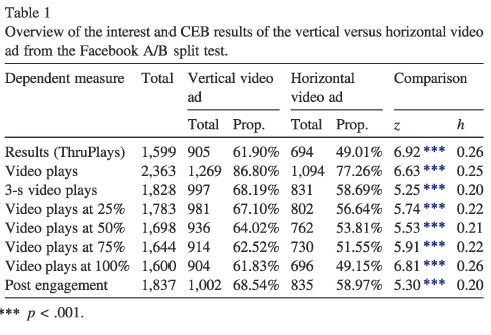
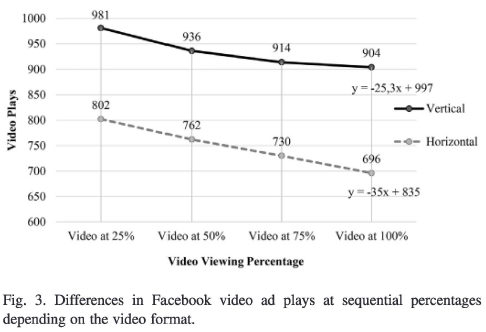
The first one explores the difference in customer engagement behavior between vertical and horizontal advertisements displayed on Facebook. The video duration of the advertisements were 15 seconds and identical in content, with the only distinction being the format. It was revealed that the vertical video was played more frequently (ranging from 25% to 100%) than the horizontal video. The call-to-action button was used at a similar frequency in both cases, suggesting that the format does not appear to be relevant in this context (Mulier et. al.,2021).
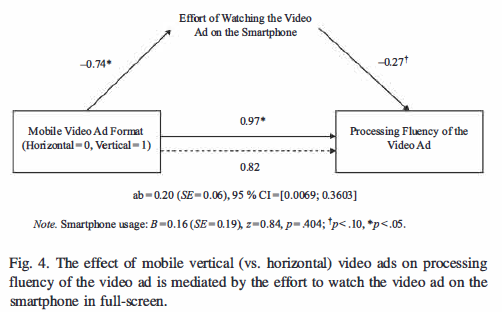
The second study explores the Effect of Mobile Vertical Video Advertising on Processing Fluency Through Effort. They recruited 110 students from a European university (17-29 years). They used two existing 62-s video ads of Nike (2015), which were equal except for the screen format.
After watching the video ad, participants answered two questions on the smartphone. One about the information and the other one about the effort. Participants in the vertical condition said that watching the video on the smartphone takes significantly less effort than in the horizontal condition. The findings from Study 2 confirm that mobile users experience less effort when watching a vertical video ad as opposed to a horizontal video ad, as watching a vertical. Mobile users process the vertical video ad more fluently than the horizontal video ad (Mulier et. al.,2021).
Mobile vertical video ads were found to increase interest, customer engagement behaviors (CEB), and information processing speed compared to traditional horizontal video ads. In addition, mobile vertical video ads were found to have higher completion rates compared to horizontal video ads.
In addition, not all people watch videos on mobile devices, especially members of the older generation. Therefore, to reach a broad audience (without specifically targeting a generation or a certain demographic segment), it is recommended to create two versions of video ads and marketing messages: one for vertical viewing on mobile devices to reach younger viewers, and one horizontal to reach older viewers (Mulier et. al.,2021).
Case Studies on Successful Vertical Video Campaigns
Today, brands use vertical video for everything, from entertainment to educational content on platforms like LinkedIn. With the rise of smartphones, vertical content is transforming how we report and consume world events. Major platforms are promoting vertical video creation and brands are investing in creating compelling content. New interactive features are revolutionizing storytelling and opening up global engagement opportunities (Sharma, 2023).
But besides Mercedes Benz, Netflix and many other brands, Instagram has probably also shaped the trend with its daily vertical stories. In the meantime, Youtube and TikTok have also made the format their own, as they had to keep up with the trend in order not to fall behind (Gilliland, 2019).
Case Study of National Geographics
A very well-known brand where the videos work well, even though one would think they should be played out in wide format for the content, is National Geographic. Despite the nature footage and sometimes long documentaries, the brand has many views on Instagram and was even chosen as a launch partner for IGTV at the time. They created the 47-minutes documentary “One Strange Rock” which generated over three million views (Gilliland., 2019).
National Geographic relies heavily on social media, which accounts for over half of the media company’s advertising revenue. Vertical video, with its appeal to authenticity, is proving to be a key strategy in keeping the audience engaged (ibid.,2023).
For National Geographic, this shift has translated into more content and audience growth, seen on Instagram and TikTok. The brand continues to educate, inform, and inspire while ensuring a profitable business perspective. From the contributor’s perspective, social media has become a valuable tool for sharing behind-the-scenes moments, allowing the audience to connect with the creators and engage in meaningful conversations about the content. In essence, the shift to more authentic, low-fi social media content complements National Geographic’s storytelling by providing a look into the creative process and the people behind the captivating imagery (Barber,2023).
The Influence of Social Media Short Video Marketing
Short video is a new type of video that can be shared, forwarded, and viewed on social media short video platforms within 3 minutes, mainly using mobile intelligent terminals for shooting and editing. The playing time ranges from a few seconds to a few minutes (Liu et al., 2019).
Social media platforms like TikTok, Instagram, and Snapchat provide good access for individuals to watch video clips of short duration, from 15 s to 1 min (Gan et al., 2023).
Paper 2 – “Influence of Social Media Short Video Marketing on Consumer Brand Attitude”
Research on the Influence of Social Media Short Video Marketing on Consumer Brand Attitude, Gao-fu LIU, Yu-chun LI, Peng-chao GAO, Zhuo-ping ZHANG, 2019 August
We can divide short video marketing of social media into three dimensions: interesting content, scene-based experience and user participation and interaction (Liu et al., 2019).
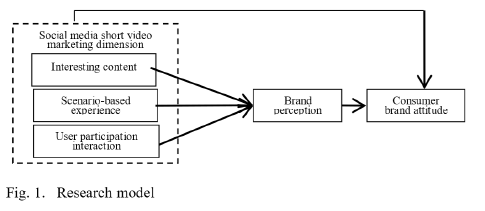
1) Interesting content has a positive impact on brand attitudes. The content with strong interest and high degree of entertainment, integrate the brand culture into the content of extensive entertainment, and enhance consumers’ cognition and emotion of the brand in a relaxed and pleasant way (Liu et al., 2019).
2) Scene-based experience has a positive impact on brand attitude. It can help to provide consumers with a real scene that can be sensed by themselves through complex designed life scenes and consumption scenes, to display brand image fully and variously and spread brand culture, to gain more consumers’ recognition (Liu et al., 2019).
3) User participation interaction has a positive impact on brand attitude. To deepen consumers understanding of the brand and stimulate the positive attitude towards the brand, the content should stimulate more users to participate in the creation and imitation of short video (Liu et al., 2019).
4) Brand perception plays an indirect role in the impact of short video marketing on brand attitude. Short videos should fully consider consumers’ visual and auditory perception, the time and way of brand exposure, and show interesting content and specific experiences to improve consumers’ brand perception and promote positive brand attitude (Liu et al., 2019)
Case Studies
The Critical Perspective
The question is if vertical video is the best option to use videos on mobile devices. Some people might prefer a horizontal viewing mode on large screens (e.g., cinema and television), but like to have a vertical viewing mode on small screens, such as smartphones or smartwatches. Next to the formats we just talked about there are also different one like square video, 360° views, etc. Considering the increasing use of different screen formats only suited for a mobile context (Mulier et. al.,2021).
Critics of the vertical video format argue that vertical video mode violates not only technical video standards, but also the laws of nature concerning human vision. Because our eyes are horizontal, we see the world as a horizontal panorama. Widescreen formats, like in television and movies, allow viewers to use their peripheral vision when watching video, to look at one part of the screen but indirectly see other parts of the screen as well.
It is therefore logical to favor horizontal displays over vertical displays. Indeed, studies of human eye movements show that smooth horizontal pursuit (eye movements that bring the image of a moving object closer to the eyeball) is superior to vertical pursuit. Furthermore, it is intuitively obvious that reading vertical text (vertically aligned letters) is slower than reading horizontal text. However, vertical format is used almost exclusively in print (Mulier et. al.,2021).
Keeping up with ever-changing trends can seem hard these days. Not so long ago, 16:9 widescreen video was the norm, but that changed before most media agencies could catch up.
The next generation device we’ll always be using could be digital glasses or something else that uses landscape orientation.
Also Cinemas will never shoot only in portrait mode because they will always be in landscape mode. Portrait orientation cameras will always be the exception, not the rule.
Conclusion
In conclusion, the appearance of vertical video as a dominant format is reshaping how brands connect with their audiences. With the preference for holding smartphones vertically, mobile users have driven the rise of vertical video content. This shift not only provides a more comfortable viewing experience but also offers to the increasingly popular demand for raw, personality-driven content on social media. Vertical video is a must for companies seeking success in this dynamic environment.
Being vertical doesn’t automatically guarantee success, as the study shows. As long as content is viewed on TVs or laptops, there will always be places for cinematic style of landscape. This means that it should be seen as an additional or alternative format.
The shift to vertical video is a response to habits of today’s audiences. Brands that embrace this change stand to benefit from higher engagement, completion rates, and audience growth.
As we move forward, vertical video is expected to play a crucial role in shaping the future of content creation, sharing, and storytelling on social media platforms.
References:
Napoli M. D. (2016). The “Mobile Effect” on Screen Format: the Case of Vertical Videos. https://www.researchgate.net/publication/311945562_The_Mobile_Effect_on_Screen_Format_the_Case_of_Vertical_Videos
Pogue D. (2018). Video Looks Most Natural Horizontally, but We Hold Our Phones Vertically – We see horizontally but tend to hold our phones vertically. https://www.scientificamerican.com/article/video-looks-most-natural-horizontally-but-we-hold-our-phones-vertically/
Gilliland, Nikki. (2019, November 23). Five examples of brands using vertical video. https://econsultancy.com/brands-vertical-video-social-examples/
Drummond-Butt S.(2019, August 25). Don’t flip that phone: Vertical video is a must for marketers [Infographic]. https://www.impactplus.com/blog/vertical-video-in-marketing-infographic
Liu G., GaoP., Li Y., Zhang Z. (2019, August). Research on the Influence of Social Media Short Video Marketing on Consumer Brand Attitude. Proceedings of the 2019 5th International Conference on Social Science and Higher Education (ICSSHE 2019) 10.2991/icsshe-19.2019.192
Pibert J. (2021). Vertikale Musikvideos. Filmpsychologische Analyse der Wirkung des Hochformats in Lena Meyer-Landruts DON’T LIE TO ME. https://mediarep.org/bitstream/handle/doc/16697/ffk_2021_6_216-228_Pibert_Vertikale_Musikvideos_.pdf?sequence=4&isAllowed=y
Mulier L., Slabbinck H., Vermeir I. (2021, February 23). This Way Up: The Effectiveness of Mobile Vertical Video Marketing. https://doi.org/10.1016/j.intmar.2020.12.002
Sharma A. (2023 , January 28). Why are marketers favouring vertical videos more and more? https://www.financialexpress.com/business/brandwagon-why-are-marketers-favouring-vertical-videos-more-and-more-2962645/
Gan J., Shi S.,Filieri R., Leung W. (2023, May 25). Short video marketing and travel intentions: The interplay between visual perspective, visual content, and narration appeal. https://doi.org/10.1016/j.tourman.2023.104795
Barber K. (2023, October 31). How National Geographic is using its contributor network to refresh its social media channels https://digiday.com/media/how-national-geographic-is-tapping-its-contributor-network-to-refresh-it-social-media-changes/
Des Res – Intellectual Standards
1. Current project idea:
The current project focuses on the exploration of video production in a vertical format. The problem is the growing demand for vertical videos due to the increasing usage of smartphones and social media platforms, which often display content in portrait orientation. The research question seeks to understand the best practices and techniques for creating engaging and visually engaging videos specifically designed for vertical viewing. The project aims to investigate the impact of vertical videos on viewer engagement, user experience, and content consumption patterns. By addressing this research question, the project aims to provide insights and recommendations for video creators to optimize their video production strategies for the vertical format.
3. Questions of different categories:
Clarity
Q: Could you give me an example?
A: The current project focuses on evaluating the impact of including motion graphics in vertical videos for educational content delivery on digital platforms.
Accuracy
Q: How could you verify or test that?
A: I could verify the impact of motion graphics in educational vertical videos through experiments, surveys, or comparative analysis.
Precision
Q: Could you give me more details?
A: I could gather feedback from learners who experienced educational vertical videos with motion graphics. Evaluate their engagement, understanding, and overall learning experience through surveys or interviews.
Relevance
Q: How does that relate to the problem?
A: The methods verify if the created motion graphic improve engagement and comprehension in online educational vertical videos.
Depth
Q: What factors make this a difficult problem?
A: User experience, content adaptation, visual design, pedagogical considerations, and technical limitations, making it a challenging problem.
Breadth
Q: Do you need to consider another point of view?
A: To consider another point of view I could look at the learner’s perspective.
Logic
Q: Does all this make sense together?
A: Yes, all the points mentioned make sense together but it is really important to look at multiple perspectives and do a lot of research.
Significance
Q: Is this the central idea to focus on?
A: Yes, the central idea to focus on.
Fairness
Q: Do you have any vested interest in this issue?
A: Since I have an education as a teacher I have expierience and interest in finding another way to combine my current education with my former in creating educational videos.
4. Potential for improvement:
Since I did not know exactly what project I could use it totaly helped me to find one. Educational vertical videos are a “new” and creative way to use videos as educational programm but is also a complex challenge. Limited screen space, attention spans, user experience, and adaptability are key considerations. To succeed, I should consider diverse perspectives, specific content, and technology for useful outcomes.
Composition of Vertical Video
To create a story, it’s important to know which shots are more likely to be used in vertical video and captivate the audience.
When shooting vertical videos and portrait photos, it’s important to know which shots work best and can captivate the audience. The taller orientation of the format is perfect for displaying narrow and tall subjects, such as towers or people, without distractions on the sides. The vertical perspective is more intimate and suitable for subjects that benefit from this orientation, such as animals, people, food, and plants. To improve the composition of these videos, applying existing rules such as the rule of thirds, which suggests placing the subject’s eye near the top intersection point, can grab the viewer’s attention. Nature elements such as trees and plants are also excellent choices for vertical-oriented compositions as they emphasize vertical lines. Strong horizons should be placed above or below the middle of the frame to make the shot more interesting. It should be avoided to crop a horizontal shot to fit the vertical format to prevent loss of quality and sharpness. Instead, shooting should be done in full-frame vertical, it forces the composer to think and compose the tall-screen framing natively, removing the need for post-processing.
There are several types of shots that work well for vertical video, including close-ups, vertical panning, symmetrical compositions, one-point perspective, and top-down shots. Close-up shots are ideal for this format, as they help the subject fill the frame and create a more intimate viewing experience. Panning up and down can be an effective way to create movement and draw the viewer’s attention to different elements of the scene. Vertical video can also be used to create strong symmetrical compositions, such as reflections in water or buildings with straight lines, while one-point perspective shots can create a strong sense of depth and draw the viewer’s eye towards a specific point. Top-down shots can be effective, especially when filming food or objects arranged on a flat surface. Overall, the best shots for vertical video are visually compelling and engaging and take advantage of the unique aspects of the vertical format.
Bibliography
Sébire, Adam. (2020, July 11). Vertical Film Festival 9:16 Tips & Tricks. https://www.adamsebire.info/vertical-film-festival/9-16-tips-and-tricks
Tran, Hannah. (2023, February 23). Vertical Video and Using Composition Rules . https://social.colostate.edu/best-practices/vertical-video-and-using-composition-rules/
Vertical projects from the field
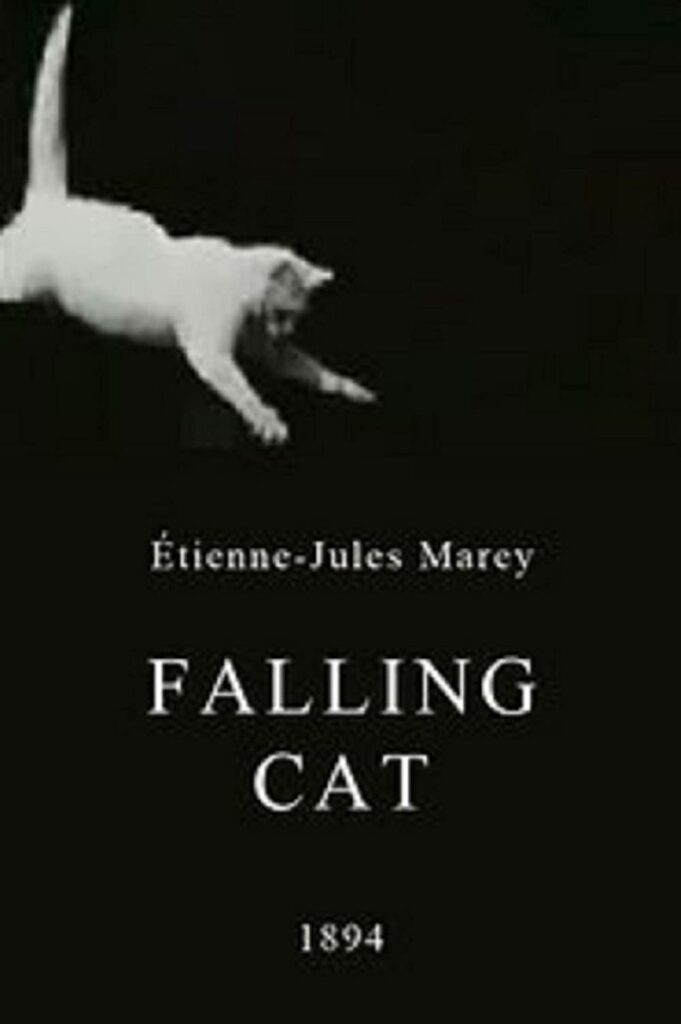
The very Beginning
People began experimenting with aspect ratios for films early on. Étienne-Jules Marey, for example, created the first vertical moving picture in 1894. This was published under the name “Falling cat” and shows exactly what the name describes: a falling cat (IMDb).
Australian television series “Content
The series consists of seven parts and belongs to the genre ScreenLife. The basic idea of the series is that it is shown exclusively from the perspective of the main character’s phone screen, which can be particularly exciting when the viewer receives private text messages or app notifications (Haridy, 2020).
The Stunt Double by award-winning filmmaker Damien Chapelle
The whole nine-minute film was produced in 2020 as an advertisement for Apple using an iPhone 11 camera. The whole film is basically a replay of famous moments from the past century of cinema, but from a vertical perspective. Chapelle’s experiment takes advantage of the vertical perspective by consistently directing the viewer’s gaze upwards or downwards through clever design techniques (ibid., 2020).
On a smartphone, it makes the viewer feel as if they are diving right into the format and shows some creative ways of framing vertical films. On a conventional horizontal screen, however, the vertical film makes little sense. The question now is whether consumers want to watch elaborately produced productions on a small smartphone or tablet (ibid., 2018)?
Quibi – Streaming platform for mobile devices
Jeffrey Katzenberger, who not only led Walt Disney through the upheaval in the 1980s and 90s but also founded DreamWorks Pictures together with Steven Spielberg, hardly missed an important trend in the entertainment industry. And he also registered the trend towards the use of smartphones and founded Quick Bites (Quibi) in 2018, which was to be a completely new kind of streaming platform (ibid., 2018).
The content will be produced for younger audiences in the form of 10-minute episodes to be played on smartphones either vertically or horizontally. Many big names from Hollywood embraced the novelty by creating lots of content all around 10 minutes long. In 2020, the app was bought by Roku, which regularly uploads new content that can be consumed for free (ibid., 2018).
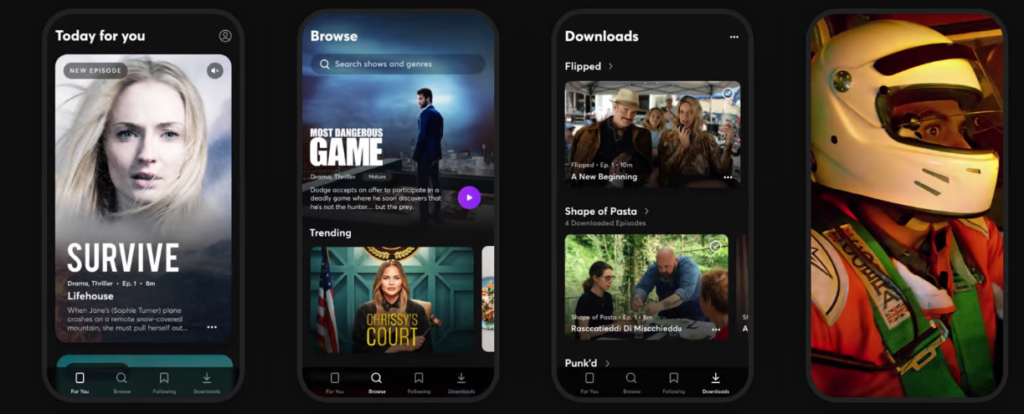
V2 – Escape from Hell
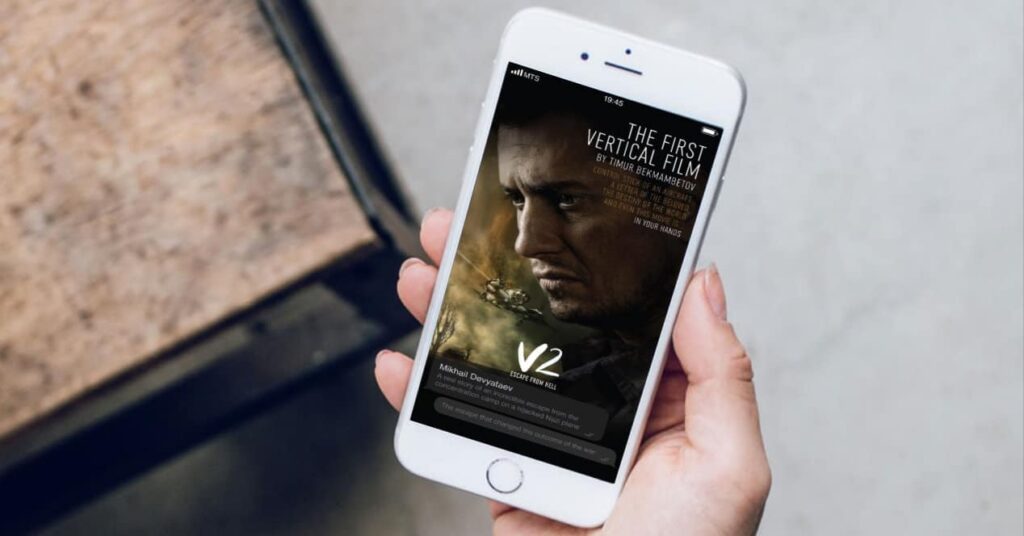
Filmmaker Timur Bekmambetov began in 2020 a production on a blockbuster about World War II: V2- Escape from Hell. The film was shot in vertical aspect ratio and the $10 million budget was partly financed through a partnership with MTS, Russia’s largest mobile operator. The film was produced in two versions: horizontal for cinemas or large TV screens and vertical for “younger audiences” on mobile phones. Bekmambetov had often realised unusual projects before. In 2019, he had already realised the Snapchat series Dead of the Night in the same format (ibid., 2018).
19:6 Livestream
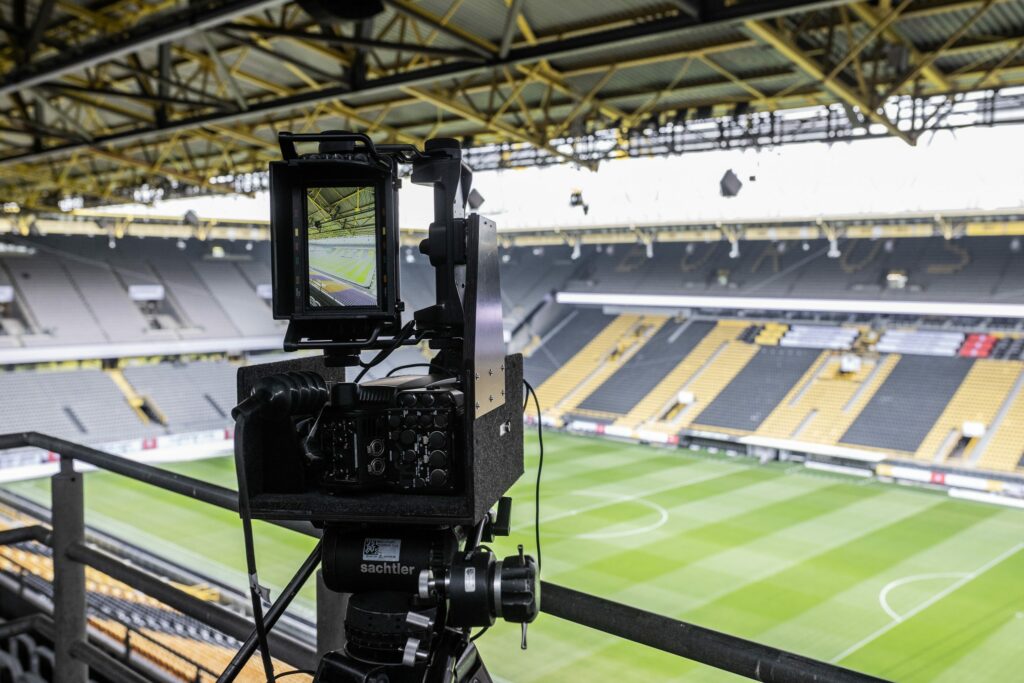
But vertical formats have also arrived in livestreaming. In 2021, for example, the Supercup was broadcast vertically for the first time in the UK and Ireland in 16:9 format via TikTok and the SkySport app. The producers are pleased with the ratings and confirmed that more viewers were reached, and more followers followed the brand (DFL, 2021).
Vertical video in commercials

With 75% of the world’s video use happening on mobile phones and many users holding them in vertical mode, it is hardly surprising that ads are also being produced in these formats. Vertical video fits both of these factors, creating an intimate, immersive and distraction-free viewing experience (Gilliland, 2019).
After Snapchat pioneered the format in 2013, more and more platforms and brands are picking up on this trend. However, not all brands use portrait formats for their videos but still insist on landscape format to convey more context and depth (ibid., 2019).
A very well-known brand where the videos work very well even though one would think they should be played out in wide format for the content is National Geographic. Despite the nature footage and sometimes long documentaries, the brand has many views on Instagram and was even chosen as a launch partner for IGTV at the time (ibid., 2019).
The Spotify brand has also picked up on the trend very successfully, engaging a number of big-name stars to shoot exclusive vertical videos for its mobile app. One notable example is Selena Gomez, whose “Bad Liar”. But other stars have already produced their music videos in vertical format alongside the classic horizontal videos (ibid., 2019).
Closing Remarks
But besides Mercedes Benz, Netflix and many other brands, Instagram has probably also shaped the trend with its daily vertical stories. In the meantime, Youtube and TikTok have also made the format their own, as they had to keep up with the trend in order not to fall behind (ibid., 2019).
For brands investing in mobile video advertising, vertical video is here to stay, but even long content can work in the format, as National Geographic shows.
Being vertical doesn’t automatically guarantee success, of course. As long as content is viewed on TVs or laptops, there will always be places with cinematic style of landscape. Moreover, videos are not only watched on mobile phones. This means that it should be seen as an additional or alternative format, or as part of a platform-specific campaign.
However, as the producers and brands above show, 9:16 has proven to be a creative, engaging and practical format for mobile audiences.
Bibliography
IMDb. Falling Cat. https://www.imdb.com/title/tt2049440/
Haridy, Rick. (2020, September 1). The ups and downs of vertical cinema. https://newatlas.com/home-entertainment/vertical-cinema-smartphone-history-aspect-ratio-quibi/
Gilliland, Nikki. (2019, November 23). Five examples of brands using vertical video. https://econsultancy.com/brands-vertical-video-social-examples/
Techsphere. (2020, September 9). Apple Short Movie | Shot on iPhone by Damien Chazelle – Vertical Cinema. https://www.youtube.com/watch?v=5f1WymwaOVo&ab_channel=Techsphere%F0%9F%A5%B2
DFL. (2021, August 23). Vertical Video: Supercup erstmals im Format 9:16 übertragen. https://www.dfl.de/de/innovation/vertical-video-supercup-erstmals-im-format-9zu16-uebertragen/
Gilliland, Nikki. (2019, November 23). Five examples of brands using vertical video. https://econsultancy.com/brands-vertical-video-social-examples/
Genres of vertical Video
For several years, the share of portrait videos has been increasing not only in advertising, but also in music videos. Back in 2015, a music video in vertical format was published on Youtube by video producer Joe Avella. He justified his decision of the aspect ratio as follows: “I’m declaring that vertical video is now the future, and you better get used to it”. (Avella, 2015) For him, it was the increasing smartphone usage and in the wake of that, by promoting videos in social media apps. However, vertical format received a lot of bad feedback in the comments (Pibert, 2021).
Three years later, however, the advertising agency of Jörn Mecher and Philipp Wolff already placed the emphasis on the portrait format. They describe their decision as follows:
Mecher: […] Die junge Zielgruppe dreht ihr Handy kaum noch in den Landescape-Modus, die Screenlock-Rate nimmt immer mehr zu. Hochformat greift genau hier ein […]. Manche Formate sehen im 16:9 schöner aus, aber das ist ein subjektives Empfinden. Denn wenn ich den Fokus bereits in der Kreation auf das vertikale Video setze, clevere Winkel verwende, kann ich vieles ausgleichen […] (Wille, 2018).
Every year, the rate of mobile advertising through videos is increasing, and for example, the spending of moving ads in China has doubled, according to “China Mobile Video Advertising Research Report 2019”. Video advertising is mainly driven up by mobile advertising and vertical short video, according to the report. Vertical short video advertising is constantly in the focus of advertisers and is becoming a new form of video advertising (Yuan, 2020, 75-78).
A study by an American research institute found that 53% of the users surveyed do not use the horizontal screen to watch videos, which is roughly consistent with the author’s daily observation results. In real life, few people use the horizontal screen to watch videos, even if the vertical screen has black borders, they can’t enjoy the full-screen effect. This is because it is very troublesome to switch the vertical screen to the horizontal screen (ebd.).
From the above analysis, vertical screen display has been accepted under the influence of various habits and has become a well-known video viewing mode. At present, the short video social platforms around the world are based on this feature and introduce the full-screen vertical display technology to improve people’s viewing experience (ebd.).
According to the “Creative Guidance Manual for Vertical Screen Advertising,” the change of video from “horizontal version” to “vertical version” also reflects the change of user habits. This change is a shift in people’s acceptance of video advertising, from still scenes to horizontal video to vertical video. Physiologically, human hands can firmly grasp the vertical display design, while the horizontal display requires the help of both hands to maintain balance. The vertical screen allows users to hold the cell phone naturally, and they can record and view in a comfortable posture (ebd.).
In short video advertising with vertical screen, the user can also see the whole smartphone screen without intentionally rotating the cell phone, which will affect the user’s experience. According to the principle of preference or ratio in communication, the audience chooses the most suitable and labour-saving medium when selecting information (ebd.).
But vertical videos are not only present in advertising, but they are also already used more and more often in music videos. In general, it can be said that a new format is more likely to prevail if it can satisfy the central needs of the recipients better than an already existing one. However, in addition to being expressive, it should also address the emotional aspect so that an added value is recognizable. The platform has also evolved from classic music television channels such as MTV and Viva to the YouTube platform, where music videos are a very important genre. From the classic television, the consumption mainly changed so that the platform is mainly accessed via the smartphone, which is why it is considered the most dominant technology of the contemporary music video experience (Pibert, 2021, p.217-219).
Besides the already mentioned two genres there are others like mini biographies, news and TV shows, animated movies and others but there is not (enough) literature, or it is very hard to find.
Bibliography:
„Vertical video is the future“. Joe Avella/Business Insider, Youtube (14.08.2015), https://www.youtube.com/watch?v=zz3Snlq1ADw (01.03.2021)
Wille, Antonia (06.08.2018): “Die Zukunft hat Hochformat“. LEAD digital. https://www.lead-digital.de/die-zukunft-hat-hochformat/ (10.10.2019).
Pibert, Johann (2021): Vertikale Musikvideos. Filmpsychologische Analyse der Wirkung des Hochformats in Lena Meyer-Landruts DON’T LIE TO ME. In: ffk Journal (2021), Nr. 6, s. 216-228. DOI: https://doi.org/10.25969/mediarep/15859.
Yuan, Le (2020): Research on Advertising Communication of Vertical Screen Short Video under Mobile Media. Probe – Media and Communication Studies. 2. 75. DOI:10.18686/mcs.v2i4.1361